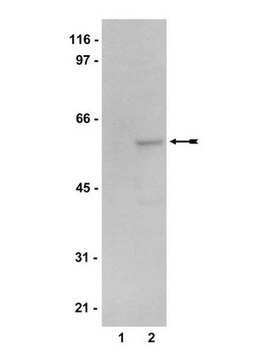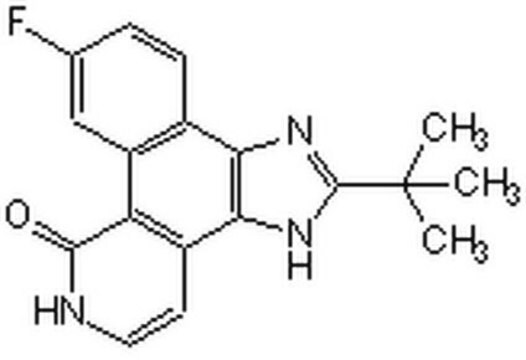495609
Okadaic Acid, Prorocentrum sp.
InSolution, ≥95%, inhibitor of protein phosphatase 1
Sinonimo/i:
InSolution Okadaic Acid, Prorocentrum sp.
Autenticatiper visualizzare i prezzi riservati alla tua organizzazione & contrattuali
About This Item
Formula empirica (notazione di Hill):
C44H68O13
Peso molecolare:
805.00
Codice UNSPSC:
12352106
Prodotti consigliati
Livello qualitativo
Saggio
≥95% (HPLC)
Forma fisica
liquid
Produttore/marchio commerciale
Calbiochem®
Condizioni di stoccaggio
OK to freeze
desiccated (hygroscopic)
protect from light
Condizioni di spedizione
wet ice
Temperatura di conservazione
−20°C
Descrizione generale
An ionophore-like polyether derivative of a C38 fatty acid compound isolated from dinoflagellates that have fed on the marine sponge Halinchrondria okadai. It is a potent non-comepetitive, reversible inhibitor of serine/threonine-specific protein phosphatases 1 (PP1, IC50 = 10-15 nM, rabbit skeletal muscle, catalytic subunit) and 2A (PP2A, IC50 = 0.1 nM, rabbit skeletal muscle, catalytic subunit). It has only a trivial effect on protein phosphatase 2B (IC50 = 5 µM), a Ca2+/calmodulin-dependent enzyme, while PP2C, a Mg2+ dependent enzyme, is unaffected. Okadaic acid has no significant effect on the activities of tyrosine phosphatases, alkaline phosphatase, acid phosphatase, and inositol trisphosphatase. It is also a non-phorbol ester-type tumor promoter on mouse skin. Useful for the study of protein phosphatases and of PP1/PP2A in cell extracts, as well as in intact cells. Induces apoptosis in human breast carcinoma (MB-231 and MCF-7) and in myeloid cells, but inhibits glucocorticoid-induced apoptosis in T-cell hybridomas. Has marked contractile effect on smooth muscles and heart muscles. Implicated as a causative agent of diarrhetic shellfish poisoning.
Azioni biochim/fisiol
Cell permeable: no
Primary Target
protein phosphatase
protein phosphatase
Product does not compete with ATP.
Reversible: no
Target IC50: 10-15 nM against protein phosphatase 1; 0.1 nM against protein phosphatase 2A
Confezionamento
Packaged under inert gas
Attenzione
Toxicity: Toxic (F)
Stato fisico
A 250 µM (25 µg/124 µl) solution of Okadaic Acid, (Cat. No. 495604) in DMSO.
Ricostituzione
Following initial thaw, aliquot and freeze (-20°C).
Altre note
Due to the nature of the Hazardous Materials in this shipment, additional shipping charges may be applied to your order. Certain sizes may be exempt from the additional hazardous materials shipping charges. Please contact your local sales office for more information regarding these charges.
Gjertsen, B.T., et al. 1994. J. Cell Sci.107, 3363.
Kiguchi, K., et al. 1994. Cell Growth Differentiation5, 995.
Ohaka, Y., et al. 1993. Biochem. Biophys. Res. Commun. 197, 916.
Gopalakrishna, R., et al. 1992. Biochem. Biophys. Res. Commun. 189, 950.
Kreienbuhl, P., et al. 1992. Blood80, 2911.
Nomura, M., et al. 1992. Biochemistry31, 11915.
Song, Q., et al. 1992. J. Cell Physiol.153, 550.
Tada, Y., et al. 1992. Immunopharmacol.24, 17.
Cohen, P., et al. 1990. Trends Biochem. Sci.15, 98.
Cohen, P. 1989. Annu. Rev. Biochem.58, 453.
Cohen, P., and Cohen, P.T. 1989. J. Biol. Chem.264, 21435.
Haystead, T.A., et al. 1989. Nature337, 78.
Kiguchi, K., et al. 1994. Cell Growth Differentiation5, 995.
Ohaka, Y., et al. 1993. Biochem. Biophys. Res. Commun. 197, 916.
Gopalakrishna, R., et al. 1992. Biochem. Biophys. Res. Commun. 189, 950.
Kreienbuhl, P., et al. 1992. Blood80, 2911.
Nomura, M., et al. 1992. Biochemistry31, 11915.
Song, Q., et al. 1992. J. Cell Physiol.153, 550.
Tada, Y., et al. 1992. Immunopharmacol.24, 17.
Cohen, P., et al. 1990. Trends Biochem. Sci.15, 98.
Cohen, P. 1989. Annu. Rev. Biochem.58, 453.
Cohen, P., and Cohen, P.T. 1989. J. Biol. Chem.264, 21435.
Haystead, T.A., et al. 1989. Nature337, 78.
Note legali
CALBIOCHEM is a registered trademark of Merck KGaA, Darmstadt, Germany
Codice della classe di stoccaggio
10 - Combustible liquids
Classe di pericolosità dell'acqua (WGK)
WGK 1
Punto d’infiammabilità (°F)
188.6 °F - closed cup - (Dimethylsulfoxide)
Punto d’infiammabilità (°C)
87 °C - closed cup - (Dimethylsulfoxide)
Certificati d'analisi (COA)
Cerca il Certificati d'analisi (COA) digitando il numero di lotto/batch corrispondente. I numeri di lotto o di batch sono stampati sull'etichetta dei prodotti dopo la parola ‘Lotto’ o ‘Batch’.
Possiedi già questo prodotto?
I documenti relativi ai prodotti acquistati recentemente sono disponibili nell’Archivio dei documenti.
Il team dei nostri ricercatori vanta grande esperienza in tutte le aree della ricerca quali Life Science, scienza dei materiali, sintesi chimica, cromatografia, discipline analitiche, ecc..
Contatta l'Assistenza Tecnica.







